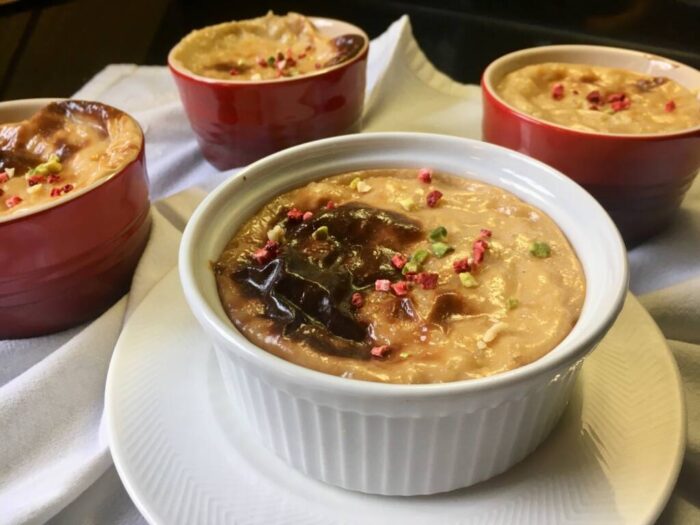
We Turks love Revani, our deliciously moist semolina sponge cake in light syrup – a popular recipe from my cookery book, Ozlem’s Turkish Table and at my cookery classes too. Recently, I came across a lovely Olive oil clementine upside down cake by Martha cooks @marthacollison, where she added clementine slices to her cake. This inspired me to have a go for my version, using semolina and orange slices.
There are many versions of Revani and traditionally when made with orange, often the zest of orange and in some cases, orange juice is used in the recipe in Turkey. With my version here, I used thinly sliced oranges cooked in syrup, as well as the fresh orange juice in the cake batter. Grainy semolina and ground almond gave a light, moist texture to the cake and the syrupy orange slices over the top of the cake made it impressive enough to serve your guests, with a citrusy, refreshing taste. I used a mixture of demerara and regular white sugar in the syrup. I like demerara’s crunchy taste and texture, and the darker colour demerara gives; you can use regular white sugar instead for the whole amount. Please to use freshly squeezed orange juice in the syrup, as it does make a difference.

This lovely, light and so easy to make Semolina cake with zesty orange slices, Portakalli Revani, can be a wonderful addition to your festive table, or to make any day special. Serve with Turkish thick (or regular) clotted cream, kaymak, crème fraiche or strained plain yoghurt, warm or at room temperature. This cake will keep for 3-4 days in an airtight container.

- 150g /5 ¼oz coarse semolina
- 30g / 1oz ground almond
- 170g / 6oz sugar
- 5ml / 1tsp baking powder
- 3 medium free range eggs, beaten
- 225g / 8oz plain whole milk yoghurt
- 60ml / 4tbsp light olive oil
- For the syrup:
- 1 medium orange, thinly sliced into round discs (skin on)
- 100g/ 3 ½ oz demerara sugar
- 150g/ 5 ¼ oz white sugar
- 85ml/ 3fl oz freshly squeezed orange juice (from 1 large orange)
- 285ml / 10fl oz water
- Ground pistachio nuts or desiccated coconut to serve (optional)
- Preheat oven to 180C / 350F
- Grease a 20cm round cake thin with a little olive oil and line with baking parchment.
- Make the syrup first. Squeeze the juice of one large orange and pour it through a sieve to get rid of the pulp. Combine the demerara sugar, regular sugar, orange juice and water in a medium to large pan. Stir and heat gently until the sugar is dissolved. Then add the orange slices and simmer gently for 30 minutes, until the orange slices softened.
- Use a slotted spoon to gently remove the slices and arrange them side by side in the prepared cake tin. Reserve the syrup and cool aside. You can prepare the syrup with the orange slices this way a day ahead of time.
- Beat the eggs and combine with the sugar in a large mixing bowl. Beat and combine well for a few minutes, until the sugar dissolves. Then add the olive oil, yoghurt, semolina, ground almond and the baking powder and beat well. Combine well until you have a smooth batter. Pour the batter into the prepared cake tin and bake in the pre-heated oven for about 30-35 minutes, until the cake is golden brown. To check; insert a toothpick into the centre of the cake, if it comes out clean, that means the cake is cooked. If not, bake for another 3-5 minutes.
- Using a large spoon, drizzle the cooled syrup all over the hot semolina cake. Let the cake absorb the syrup and cool down for 10 minutes in the tin. Then carefully turn the cake out on a large flat circle serving plate. Gently remove the baking parchment to reveal the glossy top with glazed orange slices.
- Slice and enjoy warm or cold (I love mine warm), sprinkled with ground pistachios or desiccated coconut over if you like.Turkish thick (or regular) clotted cream, kaymak, crème fraiche or plain strained yoghurt goes well by the side. This cake keeps well for 3-4 days in an airtight container.
- Afiyet Olsun.
Ozlem’s Turkish Table cookery book and Apron as Foodie Gifts!

It’s the gift giving season; Signed copies of Ozlem’s Turkish Table cookery book could make a lovely gift to a foodie, you can order a signed copy here, it is delivered worldwide including the US.

We are also delighted to offer you this special Ozlem’s Turkish Table apron, just in time for the holiday gift giving season. It is special to my heart, as it is made in Turkey, with my hometown Antakya’s celebrated daphne leaves in the hand embroidered design – this lovely apron could also make a wonderful gift for; you can get yours at this link. Delivered worldwide including the US.
Ozlem’s Turkish Table online cookery class
– Healthy Turkish food made easy –
Date : Saturday January 16th 2021
Time: 5.30pm – 7pm (GMT)
Cost: 30 GBP per person

Stuffed aubergines/eggplants – Karniyarik; a delicious main from Ozlem’s Turkish Table
Please join our small size online cookery class, where together we will make the Turkish classic, Stuffed aubegine/eggplant with minced/ground meat and vegetables, Karniyarik, as well as its vegan version with a filling of green lentils, tomatoes, onions in it, Mercimekli Karniyarik. We will also make the Cucumber and yoghurt, Cacik dip and finish off with Rice pilaf with pinenuts, currants and herbs, Ic Pilav. It will be a complete meal and you will get plenty of ahead of time preparation tips, ideas for substitution and with stories from my homeland.


My very best wishes to you all for the festive season and the New Year, in good health and happiness. Many thanks for joining me to enjoy and share my homeland’s delicious, wholesome Turkish cuisine.
Afiyet Olsun,
Ozlem


















